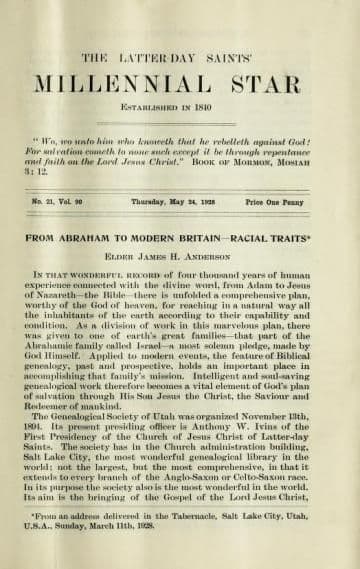Magazine
Book of Mormon Studies (24 May 1928)

Title
Book of Mormon Studies (24 May 1928)
Magazine
The Latter Day Saints' Millennial Star
Publication Type
Magazine Article
Year of Publication
1928
Editors
Widtsoe, John A. (Secondary)
Pagination
332–333
Date Published
24 May 1928
Volume
90
Issue Number
21
Abstract
This is a series of articles intended for Relief Society course study. It discusses the importance of the Book of Mormon, its coming forth (i.e., the translation, the witnesses, the publication, Joseph Smith), brief overview of its contents, and explains the text from 1 Nephi 1 through Alma 58. Each article features several questions that are helpful in synthesizing and applying the Book of Mormon to daily life.
BOOK OF MORMON STUDIES1[*]
Lehi's Descendants Separate: The testing time had come for the children of Lehi. Would they remember their father’s teachings and keep themselves righteous or would they listen to the voice of the evil one and live for selfish pleasure alone?
“Scarcely was Lehi buried than trouble arose. Laman and Lemuel, with their friends, would not be led by Nephi. They asserted that they were the elder brothers, and theirs was the right to rule. They would not recognize Nephi's authority, though they knew that God had appointed him to be their leader. So, by the command of Heaven, the two parties separated. Nephi and those who would listen to him moved away and left those who clung to Laman in possession of their first home.
“Those who went with Nephi were his own family, Zoram, Sam, Jacob and Joseph and their families, and some others whose names the Book of Mormon does not give. Henceforth those who belonged to this branch of Lehi’s house were known as Nephites, after Nephi, their leader; while those who remained with Laman were called Lamanites.
“The Nephites were those who believed in the warnings and revelations of God; while the Lamanites rejected His word and did not keep His commandments.
“After many days’ journey the Nephites pitched their tents and began to build up a new home. To the land they now occupied they gave the name of Nephi, while the region they left in the possession of the Lamanites is frequently called ‘the land of their first possession.’”2
Result of Continued Sin: Unfortunately the descendants of Laman, because of their wickedness and stubborn refusal to live the laws of God, had a mark put upon them as did the children of an earlier sinner. “Wherefore, as they were white, and exceeding fair and delightsome, that they might not be enticing unto my people the Lord God did cause a skin of blackness to come upon them.”—2 Nephi 5:21.
God’s People Build Temples: “As soon as possible after the arrival of Nephi and his people at their new home, which they called the Land of Nephi, they commenced to build a temple to the Most High God. This they were compelled to do, in order that they might observe the requirements of the law of Moses, as God had commanded them. For without a temple they could not offer the sacrifices and burnt offerings required by that law; and it was then in force to all the house of Israel, of which the Nephites were a branch, and so continued until the great sacrifice was offered up on Mount Calvary, of which all others were but types. So to fulfill the law, temples were built by the Nephites in every land that they colonized; and in different parts of the Book of Mormon we read of temples being built by them in the lands of Nephi, Lehi-Nephi, Zarahemla, Bountiful and other places. …
“The temple built in the land of Nephi was evidently patterned after that built by Solomon, for it was to be used for the same purposes; but, as the principles of the Gospel were taught to the Nephites as well as the Mosaic law, it is reasonable to suppose that many of the ordinances now administered in temples were also performed there. …
“This temple was occasionally, if not ordinarily, used for the public gathering of the Nephites. Jacob, the brother of Nephi, used it for such a purpose.” See Jacob 2:2.3
Nephi at this time appointed and consecrated his brothers Jacob and Joseph to be priests and teachers to his people. Jacob in his exhortation to the people of that day repeated in substance and at times the very words of the Prophet Isaiah. These words were transcribed from the “plates of brass” on the plates kept by Nephi, and so are reiterated to the people of this day, who doubtless need similar exhortation to that given to the people in the days of Isaiah. Indeed, one is constrained to exclaim: How human are the children of men and how much they do need and always have needed the guidance of an all-wise Father!
QUESTIONS
- Who were those who followed Nephi when they separated from the Lamanites? Why did the descendants of Lehi become two distinct peoples and how?
- Was Nephi proclaimed king? Why? What was his office?
- Give in substance the teachings of 2 Nephi, chapter 10.
- How do you explain the similarity between Jacob’s teachings and those of the Prophet Isaiah? In what way is that a testimony to you of the divinity of the record?
- Tell briefly the substance of 2 Nephi, chapter 27.
- In what way have the predictions in chapters 28 and 29 of 2 Nephi been fulfilled?
Subject Keywords
Bibliographic Citation
Terms of use
Items in the BMC Archive are made publicly available for non-commercial, private use. Inclusion within the BMC Archive does not imply endorsement. Items do not represent the official views of The Church of Jesus Christ of Latter-day Saints or of Book of Mormon Central.